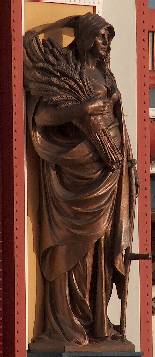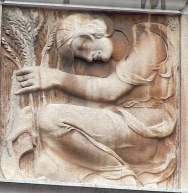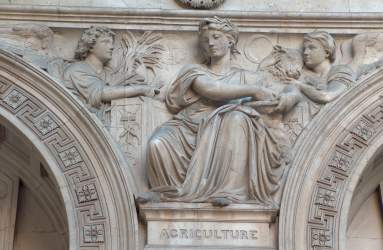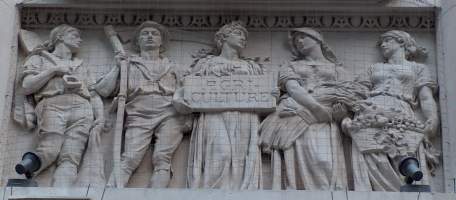 Pomeroy's Agriculture on Vauxhall Bridge.
Pomeroy's Agriculture on Vauxhall Bridge.
Agriculture has a strong place in Victorian Britain, and is the subject of many allegorical figure statues and friezes. Agriculture is often paired with Manufacture, or is in the company with Commerce or Export, as a rendition of the Empire’s success.
The figure of Agriculture can be female or male, and almost always has a sheaf of corn and very often a scythe or sickle. An alternative is a figure sowing seeds from a basket; or instead of the sickle there might be a plough, a hoe or a spade.
The attributes of allegory need to be reflected in the figure – Agriculture is vigorous, growing, fruitful and ripe, so our figures will be youthful and sturdy. The commonest male type is a strong young labourer, in open-necked shirt or stripped to the waist. The typical female Agriculture is heavily robed, often with a hood, or head-dress with ears of corn. She may be mature or youthful, but certainly not slightly-built – her arms are solid, her hips broad, her breasts full. An example with both is the group on the Albert Memorial, with bared male and two clad females – see this page. If there are several figures, we may also see a younger, milk-maid type.
Male or female, we see Agriculture as youth or maturity but not age – an old figure with a scythe might just indicate Winter – though this is much less likely to be the case than in painting or design – but generally indicates Death or Time. Allegorical figures of Agriculture are hearty and fresh - a tired or bowed figure is more likely to be emblematic of Poverty or Slavery. Related figures to Agricturure are occasionally met – the Seasons, as roundels or panels rather than free-standing statues; or, as alluded to above, some agricultural worker with their harvest may be to represent the first in a series of figures in a frieze or pediment building towards a central scene of Commerce or Trade.
There may in our Agriculture figures sometimes be a hearkening back to an earlier type – the pastoral figures popular in the 18th and earlier 19th Centuries, as lead figures in formal gardens – nice examples by John Cheere are in Kew Gardens – and these are typically less muscled, but still straight-backed young creatures, perhaps with a lamb if a girl, and often with a characteristic hat if a youth.
 Pomeroy's Agriculture on Vauxhall Bridge.
Pomeroy's Agriculture on Vauxhall Bridge.
This is an excellent Agriculture, magnificently large, with a strong farming woman, a bold sweep to her drapery, holding a hefty sheaf of corn, and by her side, a small plough. It is one of eight colossal figures on the sides of Vauxhall Bridge, the work of the excellent F. W. Pomeroy.
 Schenck's Agriculture in Harley Street.
Schenck's Agriculture in Harley Street.
Our second picture is chosen as a minimalist Agriculture, the figure filling the architectural space in the manner of Rossetti, with just room for sheaf and sickle; in Harley Street by F. E. E. Schenck.
Birnie Philip has a good Agriculture group on the façade of the Foreign and Commonwealth Office in Whitehall: the central figure dips her hand in to a bowl to take seed to scatter; her headdress is made with ears of corn. To the left is an angel carrying a full cornsheaf, to the right a companion angel holds a sheep for shearing. The short pillars forming the sides to the main figure’s seat depict tiny sickles, spades and rakes, and in the background to the composition are the sun and moon which govern the agricultural cycle.
 Birnie Philip's Agriculture for the FCO.
Birnie Philip's Agriculture for the FCO.
Our final picture, alas at a sharp angle, is of a panel on the Institute of Chartered Accountants, by Hamo Thornycroft, renowned for his epic figures of peasant farmers: The Sower, The Mower and so forth. In the panel shown here, we have two men and three women, figures of health and vitality, with brawny arms and strong necks, the sort of people we meet in the novels of Thomas Hardy. The female figures have the customary long skirts, but lighter blouses with rolled up arms; the centremost figure carries a tablet naming the group, the young central girl holds a bulky sheaf of corn, and to her right, the third girl hold a basket of fruit and leaves – it is a heavy harvest, as we see from her pose and the tension in her arm.
To the other side, two farm labourers, in trousers and loose shirts, holding a scythe and spade respectively, and one with a bag for the produce. The hat worn by the right hand figure is an example of the typical hat worn by the male allegorical figure of Agriculture, as noted above. A most satisfying expression of the concept of Agriculture.
 Agriculture group by Hamo Thornycroft.
Agriculture group by Hamo Thornycroft.
Allegorical sculpture - B // Full Alphabet of Allegorical sculpture
Sculpture in London // Sculpture in England // Sculptors
Visits to this page from 13 Mar 2014: 8,088